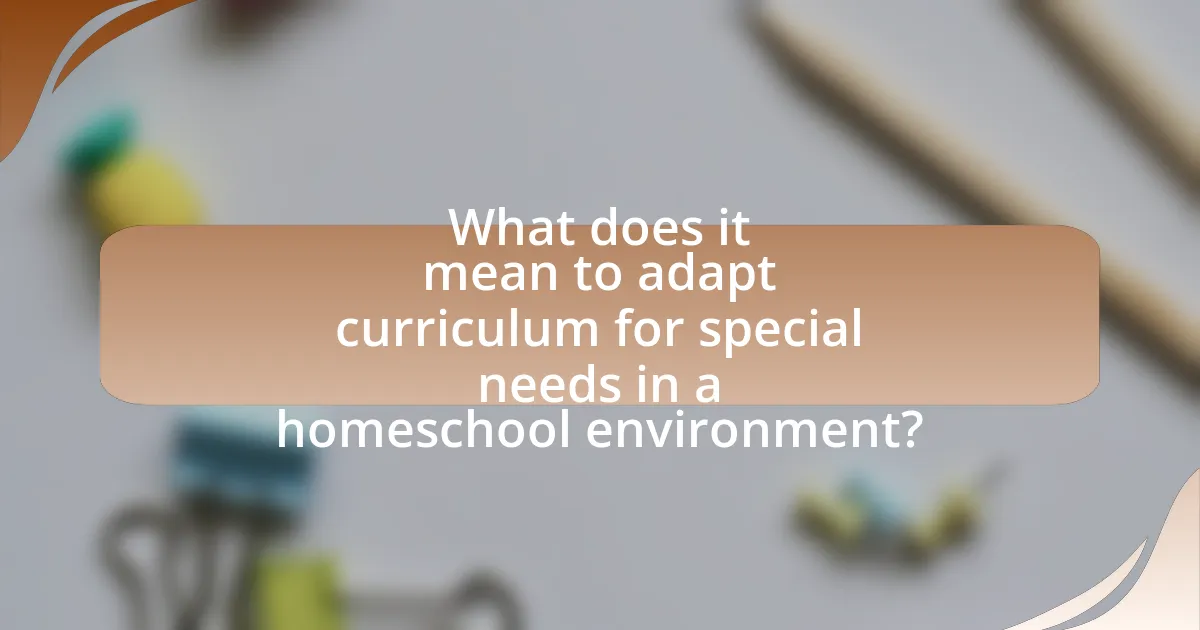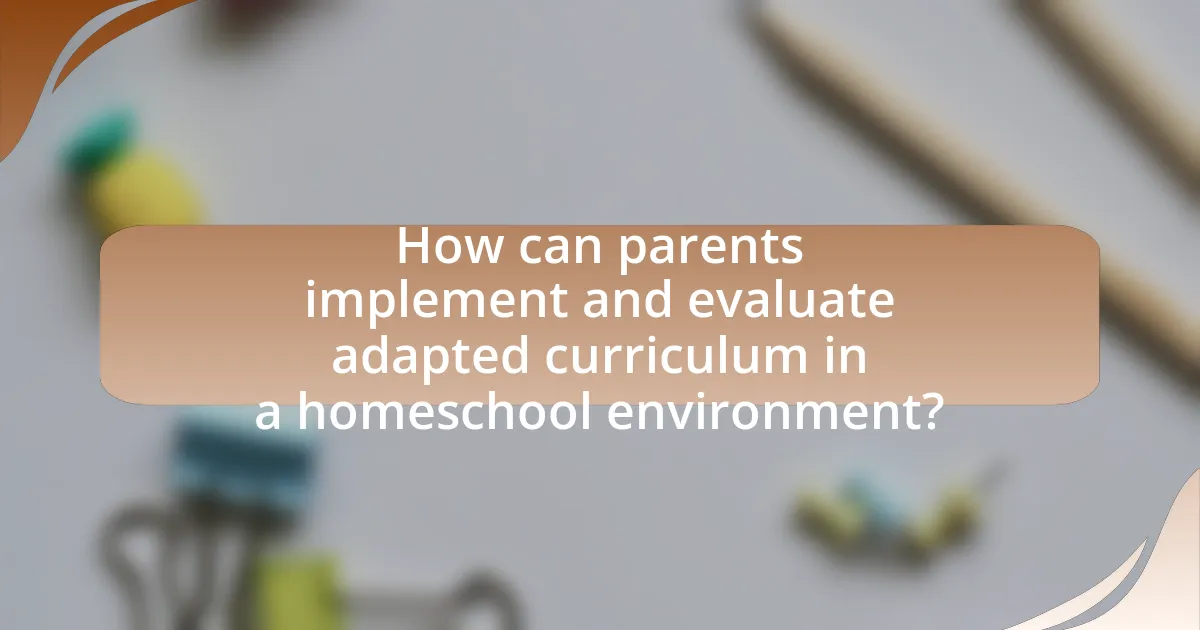Adapting curriculum for special needs in a homeschool environment involves modifying educational content and teaching methods to cater to the unique learning requirements of children with disabilities. This article outlines the importance of understanding special needs, the various types of disabilities that may require curriculum adaptation, and the impact of individual learning styles on educational strategies. It discusses effective teaching methods, assessment tools, and best practices for creating a structured learning environment that fosters engagement and success for special needs learners. Additionally, the article highlights the significance of parental involvement and available resources to support the adaptation process, ultimately aiming to enhance educational outcomes for children with special needs.

What does it mean to adapt curriculum for special needs in a homeschool environment?
Adapting curriculum for special needs in a homeschool environment means modifying educational content and teaching methods to meet the unique learning requirements of children with disabilities. This process involves assessing the individual strengths and challenges of the child, then tailoring lessons, materials, and assessments to enhance engagement and comprehension. For example, a child with dyslexia may benefit from using audiobooks and visual aids, while a child with autism might require a structured routine and sensory-friendly materials. Research indicates that personalized learning approaches significantly improve educational outcomes for students with special needs, as they allow for flexibility and responsiveness to each child’s learning pace and style.
How can understanding special needs enhance curriculum adaptation?
Understanding special needs enhances curriculum adaptation by allowing educators to tailor learning experiences that meet diverse learning requirements. This understanding enables the identification of specific challenges faced by students with special needs, such as difficulties in communication, sensory processing, or cognitive processing. For instance, research indicates that differentiated instruction, which is informed by an understanding of special needs, can lead to improved academic outcomes for students with disabilities (Tomlinson, 2014). By incorporating strategies like multi-sensory learning, individualized pacing, and alternative assessment methods, educators can create a more inclusive and effective curriculum that fosters engagement and success for all learners.
What are the different types of special needs that may require curriculum adaptation?
Different types of special needs that may require curriculum adaptation include learning disabilities, autism spectrum disorders, attention deficit hyperactivity disorder (ADHD), sensory processing disorders, and physical disabilities. Learning disabilities, such as dyslexia, affect reading and writing skills, necessitating tailored instructional strategies. Autism spectrum disorders may require modifications in social skills training and communication methods. ADHD often demands adjustments in pacing and structure to maintain focus. Sensory processing disorders may require sensory-friendly materials and environments. Physical disabilities can necessitate adaptations in physical access and learning tools. Each of these special needs presents unique challenges that can be addressed through specific curriculum adaptations to enhance educational outcomes.
How do individual learning styles impact curriculum adaptation for special needs?
Individual learning styles significantly influence curriculum adaptation for special needs by guiding educators in tailoring instructional methods to meet diverse learner needs. For instance, visual learners benefit from graphic organizers and visual aids, while auditory learners thrive with discussions and verbal instructions. Research indicates that adapting teaching strategies to align with these styles enhances engagement and retention; a study by Pashler et al. (2008) in “Psychological Science in the Public Interest” highlights that personalized approaches can lead to improved academic outcomes for students with special needs. Therefore, recognizing and incorporating individual learning styles into curriculum design is essential for effective education in a homeschool environment.
Why is it important to adapt curriculum for special needs in homeschooling?
Adapting curriculum for special needs in homeschooling is crucial because it ensures that educational content meets the unique learning requirements of each child. Tailoring the curriculum allows for individualized instruction that accommodates various learning styles, paces, and challenges, which is essential for effective learning outcomes. Research indicates that personalized education can significantly enhance engagement and retention, particularly for students with disabilities, as it addresses their specific strengths and weaknesses. For instance, a study published in the Journal of Special Education found that customized learning plans improve academic performance and self-esteem among students with special needs.
What are the potential benefits of a tailored curriculum for special needs students?
A tailored curriculum for special needs students enhances individualized learning, allowing for personalized instruction that meets each student’s unique needs. This customization can lead to improved academic performance, as it aligns educational content with the student’s learning style and pace. Research indicates that students with tailored curricula show greater engagement and motivation, which are critical for effective learning. For instance, a study published in the “Journal of Special Education” found that individualized education plans (IEPs) significantly improve learning outcomes for students with disabilities by providing targeted support and resources.
How does adapting curriculum support the overall development of special needs learners?
Adapting curriculum supports the overall development of special needs learners by providing personalized learning experiences that cater to their unique strengths and challenges. This tailored approach allows educators to modify content, teaching methods, and assessment strategies, ensuring that each learner can engage with the material at their own pace and level of understanding. Research indicates that individualized instruction significantly enhances academic performance and social skills in special needs students, as evidenced by a study published in the Journal of Special Education, which found that differentiated instruction led to improved outcomes in both cognitive and emotional development for these learners.

What strategies can be employed to adapt curriculum for special needs?
To adapt curriculum for special needs, educators can employ differentiated instruction, which tailors teaching methods and materials to accommodate diverse learning styles and abilities. This strategy includes modifying content, processes, and products based on individual student needs, ensuring that all learners can access the curriculum effectively. Research indicates that differentiated instruction can lead to improved academic outcomes for students with special needs, as it allows for personalized learning experiences that align with their strengths and challenges. Additionally, utilizing assistive technology, such as speech-to-text software or interactive learning tools, can further enhance engagement and comprehension for students with disabilities.
How can parents assess the specific needs of their child?
Parents can assess the specific needs of their child by conducting comprehensive evaluations that include observations, standardized assessments, and consultations with professionals. Observations allow parents to identify behavioral patterns, learning styles, and social interactions, while standardized assessments provide measurable data on academic skills and cognitive abilities. Consulting with educators, psychologists, or special education experts can offer insights into developmental milestones and specific challenges the child may face. Research indicates that a multi-faceted approach, combining these methods, leads to a more accurate understanding of a child’s unique needs, enabling parents to tailor educational strategies effectively.
What tools and resources are available for assessing special needs in a homeschool setting?
Tools and resources available for assessing special needs in a homeschool setting include standardized assessments, observational checklists, and specialized software. Standardized assessments, such as the Woodcock-Johnson Tests of Achievement, provide quantifiable data on a child’s academic skills, while observational checklists help parents track behavioral and developmental milestones. Additionally, specialized software like IEP Writer can assist in creating individualized education plans tailored to a child’s specific needs. These tools are essential for identifying strengths and weaknesses, ensuring that educational strategies are effectively adapted to support the child’s learning.
How can parents effectively communicate with their child to understand their needs?
Parents can effectively communicate with their child to understand their needs by actively listening and engaging in open dialogue. Active listening involves giving full attention to the child, acknowledging their feelings, and asking clarifying questions to ensure understanding. Research indicates that children who feel heard are more likely to express their needs clearly, which is crucial in a homeschooling environment where tailored curriculum adjustments are necessary. Additionally, using age-appropriate language and encouraging the child to share their thoughts fosters a supportive atmosphere, enhancing communication. This approach aligns with findings from child development studies, which emphasize the importance of responsive communication in nurturing a child’s emotional and educational growth.
What are some effective teaching methods for special needs learners?
Effective teaching methods for special needs learners include differentiated instruction, multi-sensory learning, and the use of assistive technology. Differentiated instruction tailors lessons to meet individual learning needs, allowing educators to modify content, process, and products based on each learner’s abilities. Multi-sensory learning engages multiple senses, which can enhance understanding and retention; for example, using visual aids, hands-on activities, and auditory materials can cater to various learning styles. Assistive technology, such as speech-to-text software and specialized learning apps, supports learners by providing tools that facilitate communication and comprehension. Research indicates that these methods improve engagement and learning outcomes for special needs students, as evidenced by studies showing increased academic performance and social skills development when these strategies are implemented.
How can visual aids enhance learning for special needs students?
Visual aids enhance learning for special needs students by providing concrete representations of abstract concepts, which facilitates understanding and retention. Research indicates that visual aids, such as charts, diagrams, and images, can significantly improve comprehension and engagement among students with learning disabilities. For instance, a study published in the “Journal of Special Education Technology” found that students with dyslexia showed a 30% increase in reading comprehension when visual supports were integrated into their lessons. This evidence underscores the effectiveness of visual aids in making learning more accessible and effective for special needs students.
What role does hands-on learning play in adapting curriculum for special needs?
Hands-on learning plays a crucial role in adapting curriculum for special needs by providing experiential opportunities that cater to diverse learning styles. This approach allows students with special needs to engage actively with the material, enhancing their understanding and retention of concepts. Research indicates that hands-on activities can improve cognitive and motor skills, which are often areas of difficulty for these learners. For instance, a study published in the Journal of Special Education Technology found that students with disabilities showed significant improvement in learning outcomes when engaged in tactile and interactive tasks. Thus, hands-on learning not only makes the curriculum more accessible but also fosters a more inclusive educational environment.

How can parents implement and evaluate adapted curriculum in a homeschool environment?
Parents can implement and evaluate an adapted curriculum in a homeschool environment by first assessing their child’s individual learning needs and preferences. This involves identifying specific strengths, weaknesses, and interests through observations and assessments, which can include standardized tests or informal evaluations.
Once the needs are identified, parents can select or create curriculum materials that align with these needs, ensuring that they are accessible and engaging. For example, using multi-sensory resources can enhance learning for children with different learning styles.
To evaluate the effectiveness of the adapted curriculum, parents should regularly monitor their child’s progress through formative assessments, such as quizzes, projects, or informal discussions. This ongoing evaluation allows parents to adjust the curriculum as necessary, ensuring it remains effective and relevant to their child’s evolving needs.
Research indicates that personalized learning approaches, such as those used in adapted curricula, can significantly improve educational outcomes for children with special needs (U.S. Department of Education, 2017).
What steps should parents take to implement an adapted curriculum?
Parents should begin implementing an adapted curriculum by assessing their child’s specific learning needs and strengths. This involves identifying the child’s learning style, interests, and any special requirements they may have, such as sensory sensitivities or learning disabilities. Following this assessment, parents should research and select appropriate educational resources and materials that align with their child’s needs, ensuring that these resources are accessible and engaging.
Next, parents should create a structured learning environment that minimizes distractions and promotes focus, incorporating flexible scheduling to accommodate the child’s pace and preferences. Regularly monitoring progress through assessments and observations allows parents to adjust the curriculum as needed, ensuring it remains effective and relevant.
Additionally, collaborating with educational professionals, such as special education teachers or therapists, can provide valuable insights and strategies for further tailoring the curriculum. This collaborative approach enhances the learning experience and supports the child’s development.
How can parents create a structured learning environment for special needs students?
Parents can create a structured learning environment for special needs students by establishing a consistent daily routine that includes designated times for learning, breaks, and activities. This routine helps students understand expectations and reduces anxiety, which is crucial for effective learning. Research indicates that structured environments can significantly enhance the learning outcomes for special needs students by providing predictability and stability, which are essential for their development. Additionally, incorporating visual schedules and clear instructions can further support comprehension and engagement, as evidenced by studies showing that visual aids improve focus and retention in students with learning disabilities.
What are some common challenges in implementing an adapted curriculum?
Common challenges in implementing an adapted curriculum include a lack of resources, insufficient training for educators, and difficulties in assessing student progress. These challenges arise because many homeschooling parents may not have access to specialized materials or support systems that traditional schools provide. Additionally, educators often face obstacles in understanding how to effectively modify content to meet diverse learning needs, which can hinder the successful adaptation of the curriculum. Furthermore, assessing the effectiveness of adaptations can be complex, as standardized assessments may not accurately reflect the progress of students with special needs.
How can parents evaluate the effectiveness of their adapted curriculum?
Parents can evaluate the effectiveness of their adapted curriculum by regularly assessing their child’s progress through standardized tests, observational assessments, and feedback from the child. Standardized tests provide measurable data on academic performance, while observational assessments allow parents to gauge engagement and understanding in real-time. Additionally, soliciting feedback from the child can reveal their comfort level and interest in the material, which are critical indicators of curriculum effectiveness. Research indicates that consistent evaluation methods lead to improved educational outcomes, as they allow for timely adjustments to the curriculum based on the child’s evolving needs.
What metrics can be used to assess progress in special needs learners?
Metrics that can be used to assess progress in special needs learners include individualized education plan (IEP) goals, standardized assessments, observational assessments, and progress monitoring tools. IEP goals provide specific, measurable objectives tailored to each learner’s needs, allowing educators to track achievement over time. Standardized assessments, such as the Woodcock-Johnson Tests of Achievement, offer comparative data on academic skills. Observational assessments involve direct monitoring of student behavior and engagement during learning activities, providing qualitative insights into progress. Progress monitoring tools, like curriculum-based measurements, enable frequent tracking of academic performance and skill acquisition, ensuring that interventions can be adjusted as needed. These metrics collectively offer a comprehensive view of a learner’s development and effectiveness of educational strategies.
How can feedback from the child inform curriculum adjustments?
Feedback from the child can inform curriculum adjustments by providing insights into their learning preferences, challenges, and interests. When children express their thoughts on what they enjoy or find difficult, educators can tailor the curriculum to better meet their individual needs. For instance, a study published in the “Journal of Educational Psychology” by Deci and Ryan (2000) highlights that student engagement increases when learners have a say in their educational process. This indicates that incorporating children’s feedback not only enhances their motivation but also leads to more effective learning outcomes. By actively listening to children, educators can make informed decisions that foster a more supportive and effective learning environment.
What are some best practices for adapting curriculum for special needs in homeschooling?
Best practices for adapting curriculum for special needs in homeschooling include individualized instruction, flexible pacing, and the use of multisensory teaching methods. Individualized instruction allows parents to tailor lessons to the specific strengths and challenges of their child, ensuring that learning is relevant and engaging. Flexible pacing accommodates the unique learning speed of each student, enabling them to master concepts before moving on. Multisensory teaching methods, which incorporate visual, auditory, and kinesthetic activities, enhance understanding and retention, particularly for students with diverse learning needs. Research indicates that these strategies improve educational outcomes for children with special needs, as they cater to varied learning styles and promote active participation.
How can parents foster a positive learning environment for special needs students?
Parents can foster a positive learning environment for special needs students by creating a structured and supportive atmosphere tailored to their child’s unique needs. This involves establishing a consistent daily routine that includes designated times for learning, breaks, and recreational activities, which helps students feel secure and focused. Additionally, parents should utilize individualized learning plans that accommodate specific learning styles and challenges, ensuring that educational materials are accessible and engaging. Research indicates that personalized instruction can significantly enhance learning outcomes for special needs students, as it allows for targeted skill development and promotes confidence. Furthermore, incorporating positive reinforcement strategies, such as praise and rewards for achievements, can motivate students and reinforce desired behaviors, contributing to a more effective learning experience.
What resources and communities can support parents in adapting curriculum for special needs?
Parents can access various resources and communities to support them in adapting curriculum for special needs. Organizations such as the National Association of Special Education Teachers (NASET) provide guidelines, resources, and professional development opportunities specifically for educators and parents. Additionally, online platforms like Understood.org offer tailored advice and community forums where parents can share experiences and strategies. Local support groups and special education advocacy organizations also play a crucial role in connecting parents with resources and providing emotional support. Research indicates that parental involvement in educational adaptations significantly enhances learning outcomes for children with special needs, underscoring the importance of these resources and communities.










